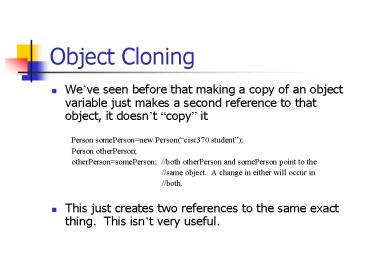Object Cloning - PowerPoint PPT Presentation
1 / 13
Title:
Object Cloning
Description:
{ try { cloneExample cloned=(cloneExample)super.clone(); cloned.someDate=(Date)someDate.clone ... { try { //write out a copy of the object to a byte array ... – PowerPoint PPT presentation
Number of Views:39
Avg rating:3.0/5.0
Title: Object Cloning
1
Object Cloning
- Weve seen before that making a copy of an object
variable just makes a second reference to that
object, it doesnt copy it - Person somePersonnew Person(cisc370
student) - Person otherPerson
- otherPersonsomePerson //both otherPerson and
somePerson point to the -
//same object. A change in either will occur in -
//both. - This just creates two references to the same
exact thing. This isnt very useful.
2
Object Cloning
- Weve also seen that some Objects can be cloned
another Object of the same type is created, which
starts in the same state, but is actually an
entirely different Object. - Some of the Java predefined types have this
behavior built-in (the Date type, for instance)
3
An Example
- In this example, both Date references point to
the same Object. A change in one will effect
both - Date someDatenew Date(1234567)
- Date newDatesomeDate
- newDate.setTime(newDate.getTime()1)
- System.out.println(someDate.getTime())
//outputs 1234568 - System.out.println(newDate.getTime())
//outputs 1234568 - In this example, we create a full new object that
starts in the same state. Now they are two
unique objects - Date someDatenew Date(1234567)
- Date newDate(Date)someDate.clone()
- newDate.setTime(newDate.getTime()1)
- System.out.println(someDate.getTime())
//outputs 1234567 - System.out.println(newDate.getTime())
//outputs 1234568
4
The Clone Method
- This works with Date objects because Date objects
implement the Cloneable interface. - The clone() method is actually inherited from the
Object superclass, and is protected by default. - Since clone() is already implemented in Object,
it means that the Cloneable interface is a tagged
interface it actually contains no methods. - Since clone() is inherited from Object, it
doesnt know anything about its subclasses
(which is every class in Java). - Is this a problem?
5
The Clone Method
- Since the clone() method belongs to the Object
superclass, it doesnt know anything about the
object its copying. - Because of this, it can only do a field-by-field
copy of the Object. - This is fine if all the fields are primitive
types or immutable objects, but if the Object
contained other mutable sub objects, only the
reference will be copied, and the objects will
share data. - This is called shallow copying.
6
The Clone method
Person ----------------------- Name
SSN SubObject
SubObject -----------------------
Original Object
Person ----------------------- Name
SSN SubObject
Cloned Object
7
The Cloning Decision
- For every class, you need to decide whether or
not - 1) The default shallow copy clone is acceptable
- 2) You need to deep-copy the class
- 3) The object is not allowed to be cloned
- For either of the first two choices, you must
- Implement the Cloneable interface
- Redefine the clone() method with the public
access modifier
8
A Cloning Example
- To implement the default clone, you must add
create a clone() method with a public access
modifier and add it to the class - public class cloneExample extends Cloneable
- publicObject clone() try
return super.clone() catch
(CloneNotSupportedException exp)
return null
9
Deep copying
- If you need to make a deep copy of a class, your
clone method must copy any mutable objects within
the class. This is more work, but necessary. - Any objects within your class that implement
Cloneable themselves should be cloned if they
do not, use the new operator to call the
constructors, and use from Strings and
primitive types.
10
Deep copying
- public class cloneExample implements Cloneable
- public Object clone()
- try
- cloneExample cloned(cloneExample)super
.clone() - cloned.someDate(Date)someDate.clone()
- cloned.theSlidernew JSlider(theSlider.getMi
nimum(),theSlider.getMaximum()) - return cloned
- catch (CloneNotSuportedException e) return
null - private Date someDate //cloneable
- private JSlider theSlider //not cloneable
11
Cloning via Serialization
- As you can see, cloning can be tedious.
- There is a way to automagically clone something
using something called Serialization. (well
cover Serialization later in the course) - Java provides a way to save objects and their
state to files. (for use in stuff like RMI, among
others) - We can use this as a way to make a Deep Copy
without going through rewriting the Cloneable()
method for every class - To do this, our class must implement the
Cloneable AND Serializable interfaces.
12
Serialized cloning
- public class Serialtest implements Cloneable,
Serializable - public Object clone()
- try
- //write out a copy of the object to a
byte array - ByteArrayOutputStream bout new
ByteArrayOutputStream() - ObjectOutputStream out new
ObjectOutputStream(bout) - out.writeObject(this)
- out.close()
- //read a clone of the object from the byte
array - ByteArrayInputStream bin new
ByteArrayInputStream(boat.toByteArray()) - ObjectInputStream in new ObjectInputStream(b
in) - Object ret in.readObject()
- in.close()
- return ret
- catch (Exception exp) return null
13
Serialized cloning
- This produces a deep copy of object, without all
the tedious work - So why not just do this every time? Why didnt
the Java creators just implement this themselves? - Mainly because this way will usually be much
slower than a clone method that explicitly
constructs a new object and copies or clones the
fields itself.































